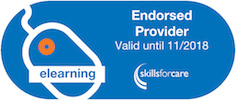Food Safety Level 2 (VTQ)


Food Safety Level 2 (VTQ) at a glance
- 3-year nationally recognised certificate
- 3 hours and 2 minutes of engaging video training
- Video access for 8 months
- Printable wall certificate
- CPD time credit conformation
- Free weekly video refresher
- Evidence Based Training certificate
- Videos include subtitles
We have been recognised as an endorsed provider from Skills for Care, earning the prestigious distinction as a Centre of Excellence within training and health & social care.
Our Food Hygiene level two course is our most popular food safety for those involved in the preparation of food. It covers all the basics of food preparation, regulations, precautions and care when preparing food for others. It is designed to meet the requirements of various regulations in food preparation, HACCP and health and safety. The course covers regulations, preparation, storage, infections, cross-contamination, reporting, PPE, date marks, reporting illness and basic first aid in the kitchen.
The course is ideal for all areas of food preparation including manufacturing, retail and catering.
The certificate is valid for 3 years and can be taken 100% fully online or nationally in the classroom with one of our approved instructors.
This is a level 2 course for general food hygiene training for people working directly with food. We also offer a level 1 course that covers the basics of food safety.
Please note that learners undertaking a ProTrainings Trainings Course have the option to choose to take a regulated qualification.
The content of this and all our courses has been independently certified as conforming to universally accepted Continuous Professional Development (CPD) guidelines and come with a Certified CPD Statement as well as a ProTrainings Certificate and for online courses an Evidence Based Learning statement.







